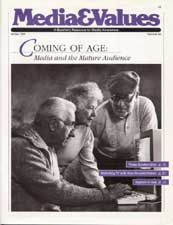Studies Analyze Elderly Use of Television
|
This article originally appeared in Issue# 45
|
Research conducted over the last 20 years offers a number of theories about the relationship between older people and TV.
- Television viewing does go up after age 50. Physical limitations related to advancing age help to explain why, according to several studies. Older people experiencing problems with seeing or hearing (which afflict at least 20 percent of people over 65) find television easier to deal with, since it provides both verbal and visual information together. Thus they may turn to it when sensory loss begins to discourage use of radio and/or print. (S. Chaffee and D. Wilson, 1975)
- Several researchers have suggested that television replaces lost social contacts for older viewers, helping them maintain an ongoing sense of participation in society and combat feelings of alienation and loneliness. A 1974 study (M. Graney) developed a theory of activity "substitution" or "compensation," which sees heavier media use as a means of compensating for financial, social and physical losses people experience as they age. According to the behavior exchanges they postulate, decreases in the ability to read and lower attendance at religious services and organizations both lead to increased TV viewing.
- Many researchers suggest increased television viewing by older people as a sign of disengagement from the world; others see it as an attempt to remain in touch. And the process is not a neutral one. The negative stereotypes of aging seen on some television programs may actually hasten withdrawal by promoting lower self-esteem, according to a study by F. Korzenny and K. Neuendorf (1980). Characterizations that depict seniors as "assets" or "hindrances" to society tend to promote self concepts that match the portrayals, research showed.



